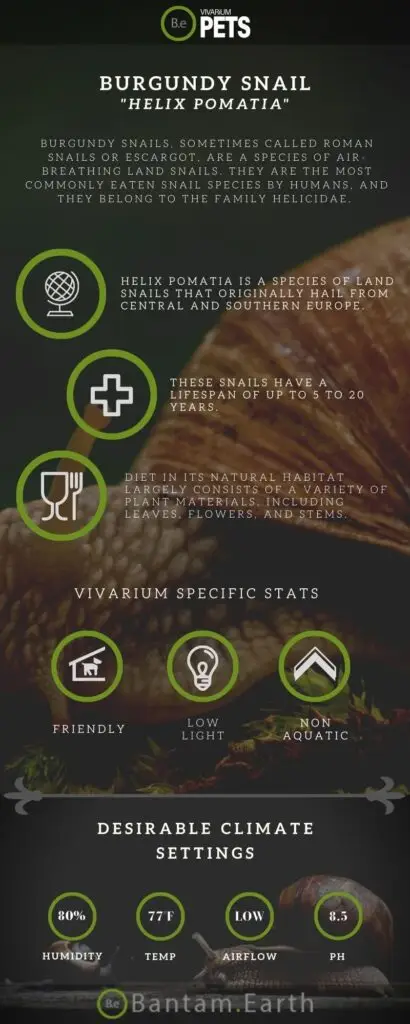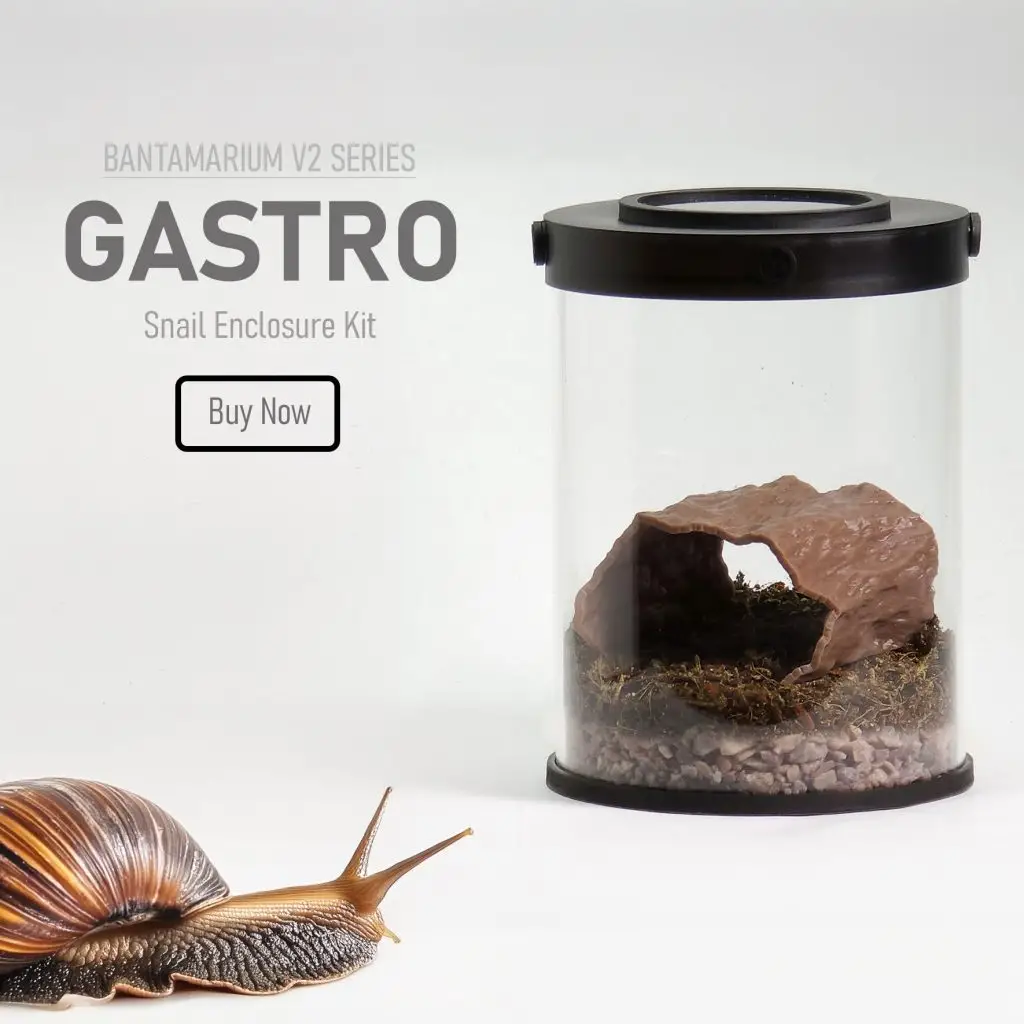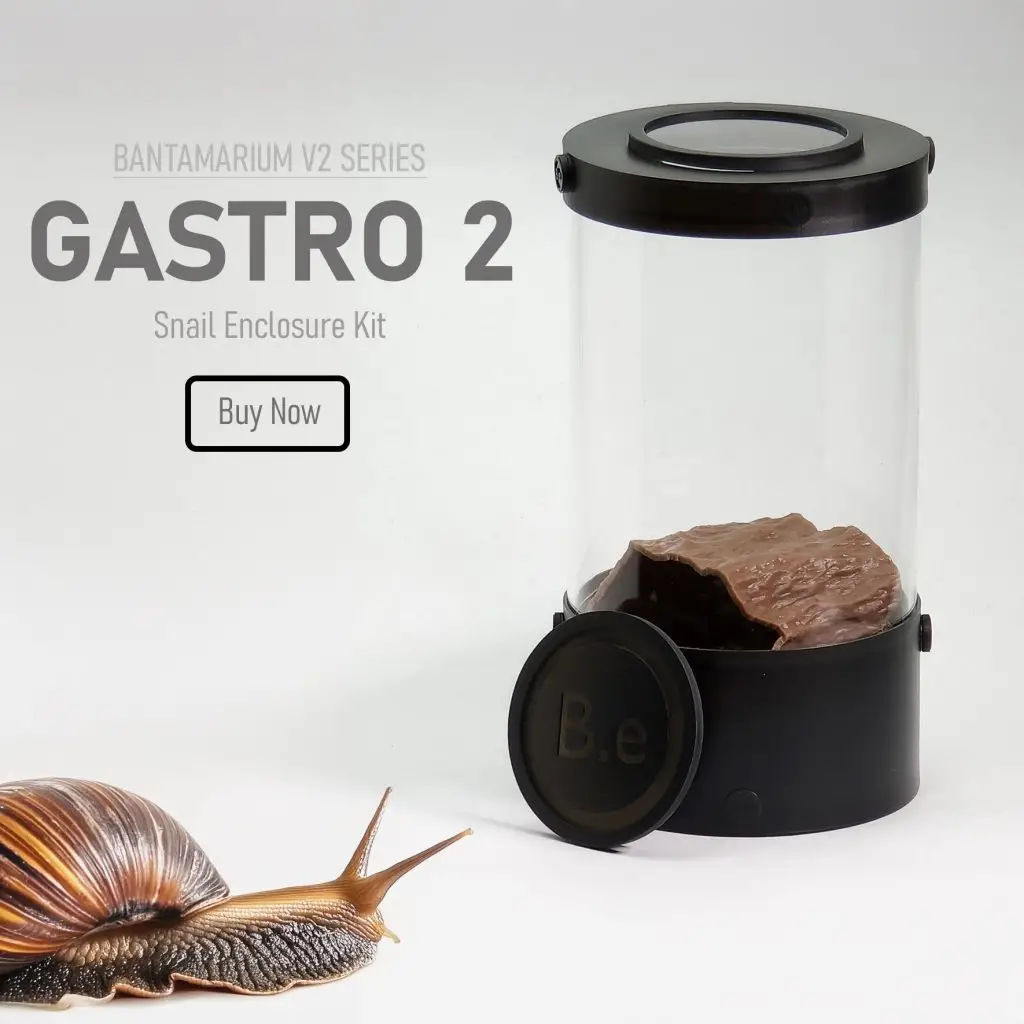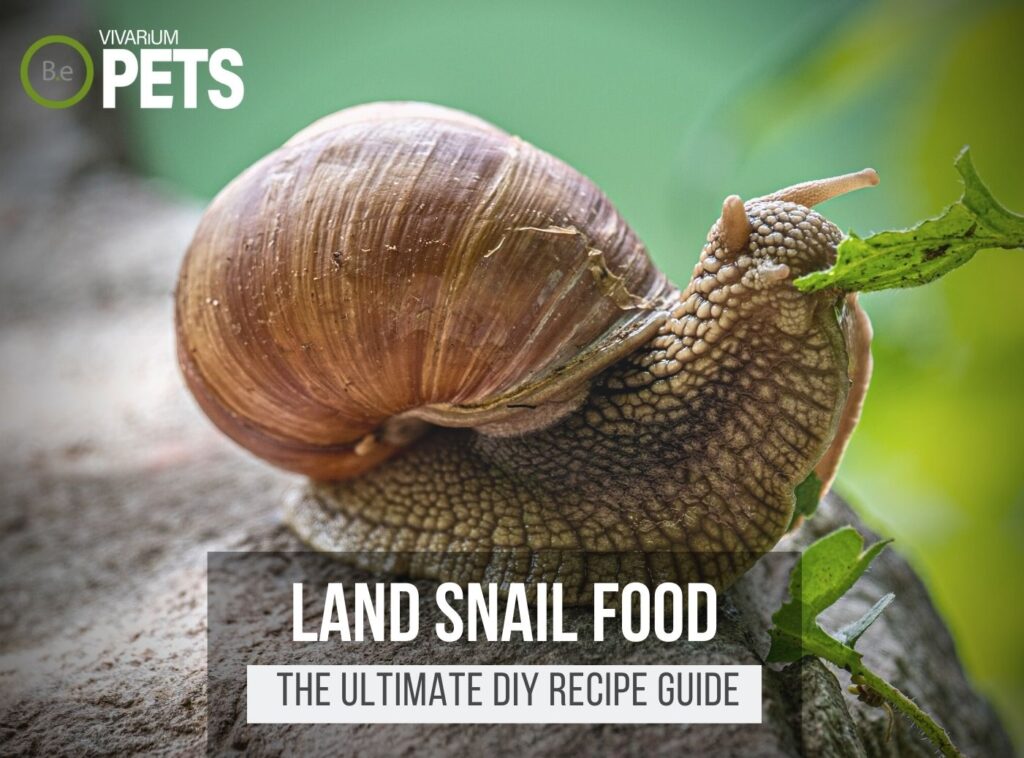Are you thinking of bringing home a little bit of the outdoors with a pet that is both unique and eye-catching?
Consider the Helix pomatia, also known as the Burgundy Snail.
These snails may look small and rather drawn out but they are a great pet if you’re looking for something that is both low maintenance and intriguing.
This guide will provide all the tips you’ll need to properly care for this terrarium snail and help them stay healthy and safe.
So let’s get started!
Table Of Contents:
ToggleWhat Are Burgundy Snails?
Burgundy snails, sometimes called Roman snails or escargot, are a species of air-breathing land snails.
They are the most commonly eaten snail species by humans, and they belong to the family Helicidae.
Their common name comes from its distinctive shiny brown shell with a deep purplish-brown stripe which can be found all over Europe.
They are very hardy animals and thrive in a humid environment in areas that feature an abundance of vegetation.
Create an ideal habitat for your pet snails with our Customizable Snail Enclosure Kits, which include everything you need to get started.
What Do Burgundy Snails Look Like?
Helix pomatia typically measures around three inches in length, with a shell diameter of up to 4 centimeters and a weight of around 3 grams.
Their shells are dark brown, almost black, and have a subtly glossy surface.
One of the defining features of the Burgundy snail is its saddle-shaped shell which can easily distinguish them from other snail species.
The Roman Snail has a very long lifespan, with some records of them living over 20 to 30 years in captivity.
They also have quite an impressive life cycle, as they take around 3-5 years before they reach maturity and can reproduce.
They also can hibernate for 6-7 months during winter.
Benefits Of Using Burgundy Snails
Burgundy snails can be very beneficial when used in vivariums as they act as part of the ecosystem in the tank, and as such, can provide several benefits.
Helix pomatia is a detritivore, meaning it consumes both broken-down plant and animal matter, keeping an enclosure clean and aiding in the decomposition of waste matter.
They also help aerate the terrarium soil, while their shell provides a sponge-like surface that helps absorb excess moisture.
Additionally, they are active during the night, and as such, provide a great and interesting addition to any nocturnal reptile or amphibian tank.
In general, Burgundy snails can help make a vivarium more aesthetically pleasing by adding beauty and color.


Burgundy Snail Facts
Helix pomatia is a species of land snail from Europe with a VERY long life span.
These land snails primarily eat vegetables, algae, and grains as part of their natural omnivorous diet.
They are generally very laid-back and docile animals, breeding every few years, and are considered a tasty appetizer to many people.
With some patience, those looking for an easy pet with a unique appearance should consider the Burgundy Snail.
Habitat
Helix pomatia is a species of land snails that originally hail from Central and Southern Europe.
They are considered a terrestrial species, however, in their native habitat, they can also be found in forested areas, meadows, and in dry fields.
Additionally, they prefer living in moist environments, among plants and vegetation.
Our Bioactive Land Snail Substrate Blend is specially formulated to meet the needs of various land snail species, providing an optimal balance of moisture and nutrients.
Diet
In their native habitat, Roman Snails are known to feed on a variety of materials such as algae, fungi, soft decaying plant material, and leaf litter.
They are also known to occasionally consume small dead or injured animals.
Temperament
The Burgundy snail is not an aggressive species and generally tends to withdraw when startled or disturbed.
As a solitary species, this snail may avoid other animals and people.
While Helix pomatia won’t attack or bite, it is important to note that it is still a wild creature and should not be handled too much.
If you do handle the Roman snails, be sure to be gentle and hold them close to the ground to avoid any drops that could cause injury.
It is also essential to be aware that this snail can become easily stressed, so make sure its living environment is pleasant and relaxing.
Lifespan
Burgundy snails, also known as European garden snails, can live anywhere from 5 to 20+ years if properly taken care of.
Burgundy snails mature quickly, usually taking up to a year or two to fully mature.
Generally, snails tend to lay eggs in the summer months as the temperature rise creates a more suitable environment for laying eggs.
When the eggs hatch, the juvenile snails may start to venture out on their own after a few months.
The juveniles are equipped to start foraging for food, making it easier for them to thrive on their own.
As the snails grow older, they begin to slow down and eventually die of old age.
Breeding
Helix pomatia are seasonal breeders and prefer to mate when the weather is nice and warm.
During the mating process, the two snails will intertwine their bodies and exchange sperm while they glide over each other’s shells.
After this, the female will begin to lay her eggs in batches of 10-20 at a time.
The eggs are small and dark brown and are usually laid in dark, moist areas like under rocks or in rotten wood.
The eggs will take 10-14 days to hatch depending on the prevailing temperature.
After the eggs hatch, the hatchlings look very similar to their parents with the same coloration and markings, just very small in size.
Where To Find Burgundy Snails
If you’d like to bring home a Helix pomatia, there are a few ways to find them.
For those who would like to observe them in the wild, Burgundy snails are found predominantly in European environments, particularly in areas with mild temperatures, such as the Mediterranean region.
Alternatively, these snails can also be purchased at local pet stores or online retailers.
When purchasing a snail, ensure that the tank is ventilated and that the snail is lively. If it appears lethargic or sluggish, seek out a different source.
Additionally, it is vital to research the state laws in your area regarding purchasing snails, as some places may have restrictions that prohibit buying and owning snails.
Regardless of where you purchase them from, be sure to acclimate the Roman snail to the tank of their new home by slowly introducing them and monitoring their behavior.
Burgundy snail Care
To care for your Burgundy snail, be sure to provide them with a warm and humid environment, feed them a variety of vegetables and fruits, and handle them with care.
Monitor for signs of a healthy or unhealthy snail, and make sure to keep their habitat clean. With proper care, Helix pomatia can live a long, pleasant life.
Tank Requirements
A 10-gallon tank is an ideal size for Burgundy Snails, however, smaller setups such as 5.5 gallons or even smaller can work too.
You’ll want to use a sealed terrarium so that your snail is prevented from crawling away.
The pH of the water should range from 6.0 to 7.2 with relatively low water hardness between 0 – 8 dKH.
The ideal temperature should be anywhere between 25 °C (77 °F) – 28 °C (82 °F) with a dry or wet substrate.
The humidity level should be kept around 80%. To help your snail navigate its home, it would also be helpful to provide some if not all of the following: rocks, wood, and hiding places.
Lastly, you won’t need any lighting for the tank, however, a standard terrarium light source will help your pet get the photoperiod it needs.
What Do Burgundy Snails Eat?
Feeding Helix pomatia is essential for keeping them healthy in captivity.
It is important to realize that Burgundy snails are mostly vegetarians and thrive on a diet of fresh produce and high-quality commercial food pellets.
Here is a list of foods you can feed your Burgundy snail:
- Leafy greens such as romaine lettuce and kale
- Dandelion greens
- Cabbage
- Pumpkin
- Squashes
- Apples
- Strawberries
- Grated carrots
- High-quality commercial pellets
When feeding your Roman snail, it is essential to use fresh produce that has not been pre-treated with pesticides.
Additionally, it is good to chop the produce into small pieces that can be easily consumed by the snail.
Depending on the size of the snail, the pieces of food should be small enough so that the snail can fit the piece into its mouth.
Also, note that Helix pomatia cannot survive on a diet of just dry pellets.
They require a diet that consists of both fresh fruits and vegetables and commercial pellets.
Additionally, Burgundy snails should be fed every one to two days with small amounts of food.
Overall, following these feeding tips will help ensure your Burgundy snail is healthy and happy.
If you’re more of an avid hobbyist like myself, be sure to check out my ultimate DIY land snail food guide. I give a more in-depth explanation of the best foods and my favorite recipe.
Best Tankmates For Burgundy Snails
Burgundy snails are excellent tank mates and can thrive in tanks with other animals such as isopods, springtails, and other snails.
They can also benefit other species by their presence, as they are excellent cleaners that feed on pieces of uneaten food and decaying plant matter.
This can help keep the tank clean and promote healthy water parameters.
Additionally, they have a peaceful nature and will not harm or compete with other tankmates.
Finally, it is best to avoid animals that can out-compete the Burgundy snail for food, as this could lead to malnutrition and health issues in the snail.
Conclusion
Caring for a Helix pomatia is essential if you want your pet snail to lead a happy and healthy life.
By following the tips in this guide, you can ensure that your Burgundy Snail can live out its full lifespan and make a great addition to your home.
From setting up a proper mini-ecosystem to ensuring your snail is properly fed and hydrated, this guide will ensure your pet snail remains healthy and lively for many years to come.
Create the ideal habitat for your snails with our species-specific soil mixes and Insect Enclosure Kits. These products provide everything you need for a successful and thriving snail habitat.
Frequently Asked Questions
No, Burgundy snails (Helix pomatia) are not endangered. They are listed as of least concern by the International Union for Conservation of Nature (IUCN).
Burgundy snails can grow to a size of 2 to 4 inches.
Burgundy snails have a relatively long lifespan for a snail, with some individuals living up to 35 years under optimal conditions. However, the average lifespan of a Burgundy snail in the wild is likely to be shorter due to factors such as predation, disease, and environmental stressors. The lifespan of these snails can also be influenced by factors such as temperature, humidity, and food availability.
The Burgundy snail has many natural predators, including reptiles, amphibians, and other invertebrates. They are also susceptible to predation from birds, mammals, and other invertebrates.
A fun fact about the Burgundy snail is that they are commonly used in French cuisine, particularly in the dish Escargots de Bourgogne, which is considered a delicacy.
Despite their popularity in French cuisine, the Burgundy snail is not native to France but was introduced to the region by the Romans over 2,000 years ago.
Yes, Burgundy snails are the same species of snail as escargot. They are typically viewed as a delicacy in French cuisine and are widely sold in grocery stores and restaurants.
Burgundy snails are found throughout Europe, especially in mountain regions. They prefer limestone soils and are commonly found in vineyards and forests.







